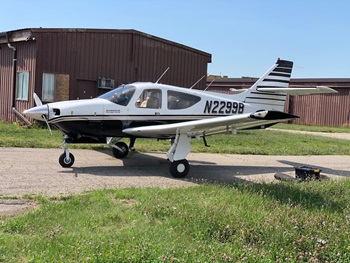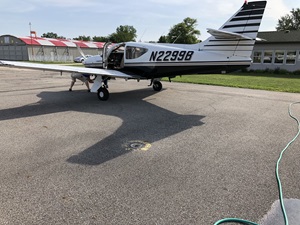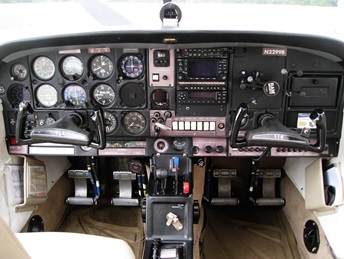
The Aircraft Spotlight feature looks at an airplane type and evaluates it across six areas of particular interest to flying clubs and their members: Operating Cost, Maintenance, Insurability, Training, Cross-Country, and Fun Factor.
Sitting on the ramp, the distinctive Rockwell Commander 114 will turn a few heads. It has a sleek, yet powerful profile sitting high on its gear. Its mid-tail elevator and large sweeping rear window makes it instantly recognizable – if you’ve seen one before. The Eximious Flying Club has a C114 based at the Oakland-Troy Airport (KVLL) in Troy, MI and it’s the only club in North America that operates one.
It’s one of three planes that the club has in its fleet. The other two aircraft are a Piper Archer II based at Coleman A. Young Municipal Airport (KDET) in Detroit and a Flight Design CTLS light sport based at Ray Community Airport (57D) in Ray, MI about 20 miles north of Detroit.
Operating Cost
The Rockwell Commander 114 is a four-seat, high-performance, retractable-gear aircraft that cruises at about 155 knots. It is an improved version of the Commander 112 that debuted in 1972 with a four-cylinder, 180-hp Lycoming IO-360.
“The 260-hp C114 version is preferred over the C112, which can be a little underpowered getting off the ground,” Eximious Operations Officer Kirk McCardell said.
The C114 has a six-cylinder, Lycoming IO-540 engine and was first produced between 1976 and 1980. The design was sold a few times and in 1992 the C114B began production with some upgrades that increased cruise speed by 8 knots.
Eximious charges $206 an hour, Tach time wet, and Kirk said the C114 burns between 15 gph and 17 gph, depending on the power setting.
An online search for a Commander 114 ranged from about $100,000 to $180,000, for a 1970s model and $190,000 to $230,000 for models produced in the 1990s. Prices may vary depending on total time and avionics.
Maintenance
Kirk said there isn’t anything unusual about maintenance on the Commander compared with other complex, high-performance aircraft. “Parts can be a little hard to come by, but for the most part it’s a pretty standard airframe,” Kirk said.
Annuals for retractable gear aircraft are more costly than fixed-gear aircraft because of the need to jack the plane up and do a gear swing. The club generally pays around $3,000 to $4,000 for an annual.
The Commander has a few differences that are worth noting. “It does have a cruciform tail, which is unusual, but also adds to the ramp appeal,” Kirk said. “It’s not a T-tail and doesn’t have a standard conventional tail where it goes through the empennage. It goes through the middle of the vertical stabilizer.”
There is a tail spar AD (AD 2012-02-10) that requires inspection for cracks every 12 months or every 150 hours, whichever comes first. Kirk said it requires a boroscope inspection and is a result of an incident that occurred during the certification phase.
The Commander also has trailing link landing gear, which helps soften landings. The club hasn’t had any problems with them, but they are a little different. Kirk did say if the shock compressions are set a little low, it possible for one wing to be a little lower than the other. To avoid any issues, the club has “taken to filling them to extend to their max point,” Kirk said. “The plane sits kind of high on the ramp” making it easily recognizable.
Insurability
Getting insurance hasn’t been a problem for the club. Eximious requires members have a minimum of 250 hours before they can fly the Commander. “We also have a 10-hour check out required with an instructor at a minimum before they can be signed off,” Kirk said. “Generally they aren’t signed off until they are consistent.”
Training
The Commander is a good platform for members to get their complex and high-performance endorsements, or commercial rating. The club also has members who have done their IFR training or recurrency in the Commander.
“Most members have the high-performance endorsement before they fly it,” Kirk said. “Generally the pilots that fly it have significantly higher time than the requirement. There have been a couple that have been close to the minimum, but most come in with a lot of experience. Some former aircraft owners have gotten into the club just to have access to the plane.”
Eximious Chief Pilot and Safety Officer Kirk Schutter is one of them. “I didn’t want to fly a 172 around,” he said. “I wanted to get into something that could go a little bit further and faster. When I found out that they were buying [the Commander], I pulled the trigger on joining.”
Cross-Country Travel
The Commander has attracted a number of professional pilots because of its comfort and range, Kirk McCardell said. “It’s fast enough and very comfortable.”
The cabin is a roomy 47-inches wide. Compare that to a Bonanza’s 42-inch-wide cabin or a Cherokee’s 41-inch cabin width, and it’s easy to understand why pilots like the Commander for longer flights.
“You also have the advantage of two doors, so everyone is not squeezing in through one side of the plane,” Kirk said.
It holds 72 gallons of fuel, with 68 gallons usable. With a fuel burn of about 15 gph and a cruise speed of about 155 kts, the plane has a comfortable four-hour range. The useful load is more than 1,000 lbs.
The plane is fully IFR capable and has a two-axis autopilot, Garmin 430 GPS and ADS-B in and out.
One of the club members, Slav Inger, uses the Commander for Wings of Mercy flights, and Kirk McCardell has flown on these missions as well. Usually, the flights are within a couple hundred miles from northern Michigan to the Chicago area, but they have flown to eastern Pennsylvania and western New York state as well.
Kirk McCardell and Kirk Schutter used the Commander for their record setting attempt to fly to all lower 48 states in 48 hours, which is featured in this month’s Club Spotlight.
Fun Factor
The Commander looks fast and strong. Sitting high on its main gear and with a wide cabin, the Commander conveys a sense of power. The cruciform tail and the large swept rear windows let you know it’s fast as well. Even parked on the ramp, it looks like a plane that is ready to get up and go.
“I like that it has ramp appeal and good visibility all around, it’s got a lot of glass,” Kirk Schutter said. “It’s a pretty honest handling aircraft.”
It’s also a plane that will attract members to the club. Eximious has one member that drives more than 50-miles just to fly the Commander.
Overall
For a club looking for solid cross-country aircraft that offers good visibility, a roomy cabin, good speed and something that will attract a little attention, the Rockwell Commander 114 is a good choice.
“It’s a very comfortable well handling airplane. It’s good for IFR operations, very stable,” Kirk McCardell said. “Whether it’s slightly loaded or near gross it seems very capable. It’s a good airplane. We chose one that already had an updated paint scheme and it has a lot of ramp appeal.”
“It’s a burly bird,” Kirk Schutter said. “It goes nice and strong.”